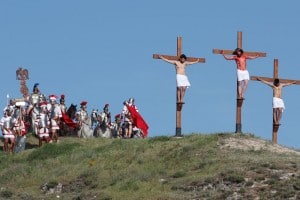 On Good Friday in the sixteenth century, people would attend a church ceremony known as “Creeping to the Cross”. Jesus Christ’s suffering and crucifixion, and what it meant, were commemorated by the clergy getting down on their hands and knees and creeping up to a crucifix held up before the altar. This “creeping” would culminate in the clergy kissing the feet of Christ on the cross. The crucifix was then taken down into the church for the congregation to do the same.
On Good Friday in the sixteenth century, people would attend a church ceremony known as “Creeping to the Cross”. Jesus Christ’s suffering and crucifixion, and what it meant, were commemorated by the clergy getting down on their hands and knees and creeping up to a crucifix held up before the altar. This “creeping” would culminate in the clergy kissing the feet of Christ on the cross. The crucifix was then taken down into the church for the congregation to do the same.
Another tradition on this day was the preparing of the Easter Sepulchre. The sepulchre consisted of a stone or wooden niche, to represent Christ’s sealed tomb. This sepulchre was filled with the consecrated host and an image of Christ. It was sealed by covering it with a cloth and then candles were lit around it. As the Roman soldiers guarded the tomb of Christ, members of the church would guard the sepulchre until it was opened on Easter Sunday.
Photo: Taken by Tim Ridgway at “La Semana Santa Viviente de Cuevas del Campo”, Easter 2014.